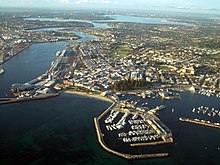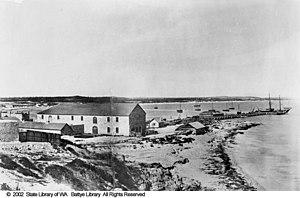Bathers Beach Whaling Station
The Bathers Bay Whaling Station (German: Bathers Bay whaling station ) was at Arthur Head at the Bathers Bay (also Whalers Bay called) on the Bathers Beach in Fremantle , Western Australia . The whaling station operated intermittently from 1837 until the mid-1840s.
This whaling station was of great importance for the development of what was then the Swan River Colony , later Western Australia, because whaling was the main source of necessary income from exports until the 1850s. Today the location of the historic whaling station has become a popular leisure place for water sports enthusiasts and those seeking relaxation.
Location and importance

Arthur Head is a headland that lies at the eastern entrance to the port of Fremantle, on the so-called Inner Habour . This headland and the east adjoining Bathers Beach on Bathers Bay , had great importance for the shipping industry of the British Swan River Colony, which was on the verge of failure due to a failed economic policy by the United Kingdom . This is where the roots of Western Australia's whaling and shipbuilding industries lie, as the whaling industry made up the bulk of the colony's exports until the 1850s. In December 1836, James Stirling founded the Western Australia whaling industry in Fremantle when he began building boats for whaling. James Stirling was the British colonial administrator at the time and was later appointed the first governor of Western Australia.
history
In 1837 the Fremantle Whaling Company was founded , which built its whaling station at Arthur Head . The company expected high profits from a successful whaling . First of all, buildings for the whale oil boiler, barrel production, boat shed, warehouse and a station house were built. The stone warehouse building had two floors. Furthermore, a 22.9 meter long jetty made of hardwood was built, on which not only the whaling boats could dock. This jetty was removed in 1871. Behind the whaling station rises a 15 meter high rock face. The Fremantle Waling Company built a 57-meter-long tunnel into the limestone rock to provide access to the high street for workers and appropriate transportation into the city . After five months of construction, during which prisoners from the local prison were also deployed, the tunnel was completed with the use of picks and shovels. The entire structure in Fremantle was not only met with approval, as the recycling of the whales, which is located directly in the city, was associated with nuisance from smoke and smells and was not considered representative of those arriving.
During the time the whaling station was operating, local Aborigines camped nearby as well. This is taken as evidence that this was their ancestral land. Traces and artifacts of them were also found on the beach and on the rock.
The new company had very little capital. It employed between 19 and 20 whale hunters on boats. However, the sperm whales passed Bathers Bay at a greater distance than expected. In addition, these whales were able to dive deep there. They could also swim much faster than the southern right whales . As a result, the rowing boats were unable to follow them and could not reach deep swimming whales with their harpoons. Only the slowly swimming southern right whales could be shot. However, significantly less whale oil could be obtained from them . In 1838 exports amounted to just 3,380 pounds and in 1839 3,170 pounds of whale oil. When the prices for whale oil and whalebone also fell, whaling was no longer profitable and the whaling station had to be closed. In addition, the domestic whaling industry came into competition with the American whalers .
Three years later, the prices of whale products rose again and the Fremantle Whaling Company resumed fishing. The whaling station was resold to various whaling companies, including the Cheyne Beach Whaling Company , until the mid-1840s . When prices fell again towards the end of the 1850s due to the discovery of oil and the associated production of petroleum, the whaling station had to close for good.
Ships were then built and repaired on the grounds of the polling station. As a result, this industry continued to develop.
today
The location of the buildings and the jetty are still known today. In 1983, whale bones were found all over the beach, particularly in the northern half of the bay.
Today there is a sandy beach on the grounds of the whaling station. The only reminder of the whaling station is the tunnel, which was dug into the rock in 1837 and which now allows access to the beach for recreational athletes and those seeking relaxation. The tunnel through limestone is now known as the Whalers Tunnel .
Web links
Individual evidence
- ^ A b C. Souter, M. McCarthy: The Maritime archaeological Resource at Arthur Head (PDF), on Department of Maritme Archeology, Western Australia Maritime Museum, Report No. 145. Retrieved August 5, 2019. p. 4.
- ^ Jack McIlroy: Bathers Bay Whaling Station, Fremantle, Western Australia (PDF). In: Australian Historical Archeology, 4th 1986. Retrieved August 5, 2019. p. 41.
- ^ Jack McIlroy: Bathers Bay Whaling Station, Fremantle, Western Australia (PDF). In: Australian Historical Archeology, 4th 1986. Retrieved August 5, 2019. p. 45.
- ^ Jack McIlroy: Bathers Bay Whaling Station, Fremantle, Western Australia (PDF). In: Australian Historical Archeology, 4. Retrieved August 5, 2019. 1986, p. 44
- ^ Jack McIlroy: Bathers Bay Whaling Station, Fremantle, Western Australia (PDF). In: Australian Historical Archeology, 4th 1986. Retrieved August 5, 2019. p. 46.
- ^ Jack McIlroy: Bathers Bay Whaling Station, Fremantle, Western Australia (PDF). In: Australian Historical Archeology, 4th 1986. Retrieved August 5, 2019. p. 49.
- ↑ a b Jack McIlroy: Bathers Bay Whaling Station, Fremantle, Western Australia (PDF). In: Australian Historical Archeology, 4th 1986. Retrieved August 5, 2019. p. 43
- ^ Jack McIlroy: Bathers Bay Whaling Station, Fremantle, Western Australia (PDF). In: Australian Historical Archeology, 4th 1986. Retrieved August 5, 2019. p. 50
- ^ Jack McIlroy: Bathers Bay Whaling Station, Fremantle, Western Australia (PDF). In: Australian Historical Archeology, 4th 1986. Retrieved August 5, 2019. p. 48
Coordinates: 32 ° 3 ′ 24 ″ S , 115 ° 44 ′ 27 ″ O

